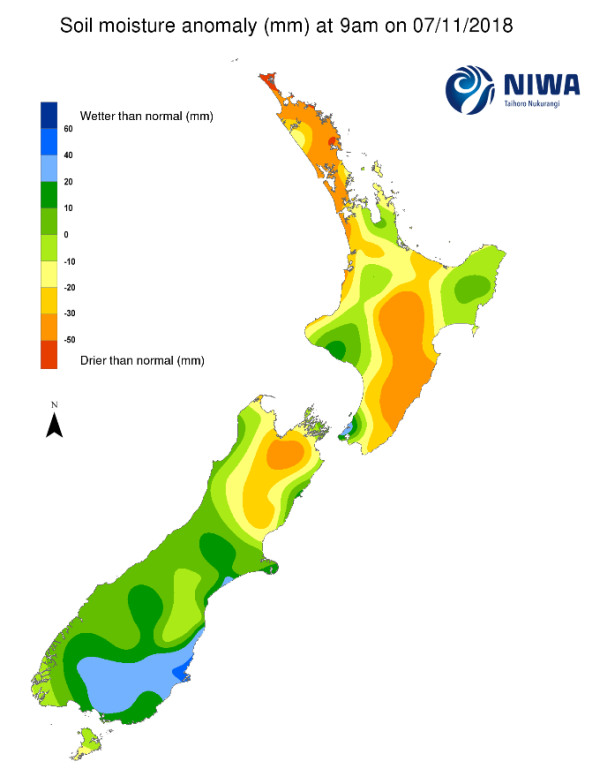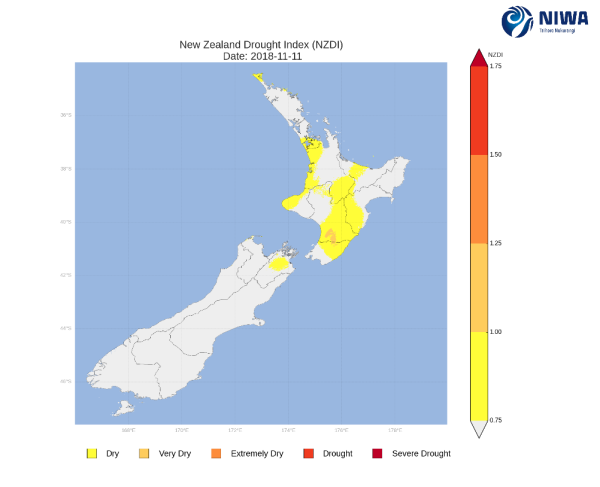A weekly update describing soil moisture across the country to help assess whether severely to extremely dry conditions are occurring or imminent. Regions experiencing these soil moisture deficits are deemed “hotspots”. Persistent hotspot regions have the potential to develop into drought.
Facts: Soil Moisture
Across the North Island, soil moisture levels generally decreased or stayed constant in the in the past week. Decreases occurred in Wairarapa, Central Plateau, parts of Waikato, along with small areas of Auckland and parts of Northland. Slight improvements were observed in the Coromandel and Great Barrier Island. The driest soils across the North Island compared to normal for this time of the year are found in Whangarei and Kaipara districts, along with Taupo and Tararua. The wettest soils for this time of the year are located along the Kapiti Coast.
The largest hotspot in the North Island has expanded across southern Hastings and the Central Hawke’s Bay District. The hotspot near Cape Reinga has continued to grow across more of Aupouri Peninsula in the past week.
Across the South Island, soil moisture generally improved due to the heavy rain that fell in the past week. The biggest improvement was found east of the divide, especially from central Canterbury to Otago. Slight decreases in soil moisture levels occurred around the Waimea Inlet in Richmond. The driest soils across the South Island compared to normal for this time of the year are found in interior Marlborough, eastern Tasman and Nelson, while the wettest soils are found from Dunedin to southern Canterbury.
Despite dry soils in northeastern Marlborough, this area does not meet the requirements to be declared a hotspot. No hotspots are currently in place in the South Island.
Outlook and Soil Moisture
In the North Island, high pressure will continue to bring settled weather over the next several days and rainfall is expected to be fairly sparse. Through the upcoming weekend a few isolated showers will occur, but rainfall amounts will be minimal. However, a system arriving by early next week (Monday 19 November) may bring some significant rainfall to parts of the upper and eastern North Island where rain amounts may exceed 50 mm in lower elevations with higher rain amounts likely in the ranges.
With the rain amounts expected in the east and north, soil moisture levels are anticipated to improve in the next week, while soil moisture should stay near constant or slightly decrease in the rest of the island where many locations will see total rain amounts less than 15mm.
With the expected rainfall in the east and north, the current hotspots around Cape Reinga and along the east coast are expected to decrease at least slightly.
In the South Island, a front will move up the island on Friday (16 November), resulting in moderate rainfall mainly in the west and south extending into the weekend (17-18 November). Isolated rainfall amounts exceeding 75 mm are possible in the West Coast and Fiordland, while lower elevations in the rest of the west and south may see localised rainfall amounts over 30 mm.
However, parts of the Nelson - Marlborough Region (where the most anomalously dry soils are found) is expecting total rain amounts less than 15 mm in the next week. Consequently, a small hotspot may begin to form there.
The New Zealand Drought Index (NZDI) map below shows a few dry areas across the North Island and the upper South Island as of 11 November. Please note: some areas with dry soils do not yet appear on the NZDI map, mainly because the NZDI uses additional dryness indices including one which integrates the rainfall deficit over the past 60 days. Changes are therefore slower to appear in the NZDI compared to the instantaneous status maps of soil moisture anomaly.
Background:
Hotspot Watch a weekly advisory service for New Zealand media. It provides soil moisture and precipitation measurements around the country to help assess whether extremely dry conditions are imminent.
Soil moisture deficit: the amount of water needed to bring the soil moisture content back to field capacity, which is the maximum amount of water the soil can hold.
Soil moisture anomaly: the difference between the historical normal soil moisture deficit (or surplus) for a given time of year and actual soil moisture deficits.
Definitions: “Extremely” and “severely” dry soils are based on a combination of the current soil moisture status and the difference from normal soil moisture. Refer to soil moisture maps for more information.
The New Zealand Drought Index (NZDI) map below shows a few dry areas across the North Island and the upper South Island as of 11 November. Please note: some areas with dry soils do not yet appear on the NZDI map, mainly because the NZDI uses additional dryness indices including one which integrates the rainfall deficit over the past 60 days. Changes are therefore slower to appear in the NZDI compared to the instantaneous status maps of soil moisture anomaly.
The New Zealand Drought Index (NZDI) map below shows a few dry areas across the North Island and the upper South Island as of 11 November. Please note: some areas with dry soils do not yet appear on the NZDI map, mainly because the NZDI uses additional dryness indices including one which integrates the rainfall deficit over the past 60 days. Changes are therefore slower to appear in the NZDI compared to the instantaneous status maps of soil moisture anomaly.



